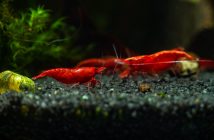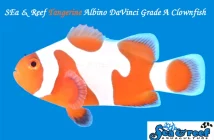When it comes to rare and unusual wild caught clownfish, the crew at iBluewater seem to have the inside track. Besides the rare white cap skunk clownfish and the rather attractive Picasso maroon clownfish caught last year, they recently found a navy blue tomato clownfish (Amphiprion frenatus) that is just out of this world. The fish sports a rich blue coloration on its face, with a much darker shade of blue (almost black) covering the rest of its body. The bold vertical white stripe behind the blue clownfish’s eye appears as normal for the most part, but the overall coloration really sets it appart from its normal looking counterparts, which have a dark reddish orange face and nearly reddish black body.
According to the story posted on the 3reef forums, collectors working for iBluewater had spotted a blue tomato clownfish while they were on the hunt for the white cap skunk clownfish. The sightings were originally written off as “villagers’ tales”, which we could understand, and were basically ignored because the goal at the time was to catch the white cap skunk clown. Then, 5 weeks ago, a collector called to say that they had caught the fabled blue clownfish.
Photos were sent back to iBluewater for a confirmation, and obviously they were overjoyed by the sight of a navy blue tomato clownfish.
After combing over the photos, here’s the description that Bob and the rest of the crew from iBluewater came up with:
Navy blue with purple hues is the color of the entire body of this fish. The lower forehead, front face and upper and lower lips are a bluish lavender-purple. Spinous portion of its dorsal fin have similar coloration to the body, and the soft rayed portion is light translucent purple. Pelvic and anal fins also have similar coloration to the body. Pectoral fins are purple from the body to half way out, then lightly translucent purple from the half way point to the tip. Caudal fins are translucent pastel purple. The white band is clear white, with jagged edges from top to bottom, and bright turquoise color towards the lower bottom of the band. Scales on its body appear small to medium size giving it a smooth leathery look, instead of the more obvious scales and “pixelated” look of, say, the Madagascar Anemonefish (A. Latifasciatus). There are no noticeable red, orange, or orange-red coloration on this fish.
It’s quite an attractive clownfish and possibly the only one of its kind in captivity.










Pingback: Our Most Interesting Livestock Stories from 2013 | AquaNerd()